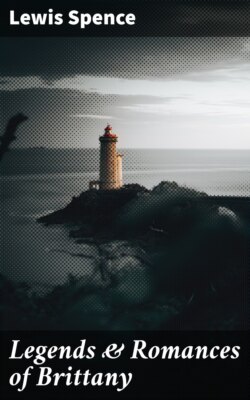Читать книгу Legends & Romances of Brittany - Льюис Спенс - Страница 5
CHAPTER I: THE LAND, THE PEOPLE AND THEIR STORY
ОглавлениеThe romantic region which we are about to traverse in search of the treasures of legend was in ancient times known as Armorica, a Latinized form of the Celtic name, Armor (‘On the Sea’). The Brittany of to-day corresponds to the departments of Finistère, Côtes-du-Nord, Morbihan, Ille-et-Vilaine, and Loire-Inférieure. A popular division of the country is that which partitions it into Upper, or Eastern, and Lower, or Western, Brittany, and these tracts together have an area of some 13,130 square miles.
Such parts of Brittany as are near to the sea-coast present marked differences to the inland regions, where raised plateaux are covered with dreary and unproductive moorland. These plateaux, again, rise into small ranges of hills, not of any great height, but, from their wild and rugged appearance, giving the impression of an altitude much loftier than they possess. The coast-line is ragged, indented, and inhospitable, lined with deep reefs and broken by the estuaries of brawling rivers. In the southern portion the district known as ‘the Emerald Coast’ presents an almost subtropical appearance; the air is mild and the whole region pleasant and fruitful. But with this exception Brittany is a country of bleak shores and grey seas, barren moorland and dreary horizons, such a land as legend loves, such a region, cut off and isolated from the highways of humanity, as the discarded genii of ancient faiths might seek as a last stronghold.
Regarding the origin of the race which peoples this 14 secluded peninsula there are no wide differences of opinion. If we take the word ‘Celt’ as describing any branch of the many divergent races which came under the influence of one particular type of culture, the true originators of which were absorbed among the folk they governed and instructed before the historic era, then the Bretons are ‘Celts’ indeed, speaking the tongue known as ‘Celtic’ for want of a more specific name, exhibiting marked signs of the possession of ‘Celtic’ customs, and having those racial characteristics which the science of anthropology until recently laid down as certain indications of ‘Celtic’ relationship—the short, round skull, swarthy complexion, and blue or grey eyes.
It is to be borne in mind, however, that the title ‘Celtic’ is shared by the Bretons with the fair or rufous Highlander of Scotland, the dark Welshman, and the long-headed Irishman. But the Bretons exhibit such special characteristics as would warrant the new anthropology in labelling them the descendants of that ‘Alpine’ race which existed in Central Europe in Neolithic times, and which, perhaps, possessed distant Mongoloid affinities. This people spread into nearly all parts of Europe, and later in some regions acquired Celtic speech and custom from a Celtic aristocracy.
It is remarkable how completely this Celtic leaven—the true history of which is lost in the depths of prehistoric darkness—succeeded in impressing not only its language but its culture and spirit upon the various peoples with whom it came into contact. To impose a special type of civilization upon another race must always prove a task of almost superhuman proportions. To compel the use of an alien tongue by a conquered folk necessitates racial tact as well as 15 strength of purpose. But to secure the adoption of the racial spirit by the conquered, and adherence to it for centuries, so that men of widely divergent origins shall all have the same point of view, the same mode of thought, manner of address, aye, even the same facies or general racial appearance, as have Bretons, some Frenchmen, Cornishmen, Welshmen, and Highlanders—that surely would argue an indwelling racial strength such as not even the Roman or any other world-empire might pretend to.
But this Celtic civilization was not one and undivided. In late prehistoric times it evolved from one mother tongue two dialects which afterward displayed all the differences of separate languages springing from a common stock. These are the Goidelic, the tongue spoken by the Celts of Scotland, Ireland, and the Isle of Man, and the Brythonic, the language of the Welsh, the Cornish, and the people of Brittany.
